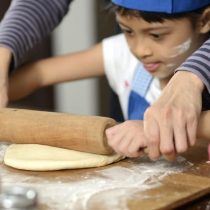
In these days of confinement one of the products that has increased its sale the most is flour. This tells us that people have taken advantage of the time we now have to cook more. Something good had to have this quarantine. One of the products we are making with flour is bread, because it also highlights the increase in yeast sales. In some cases the children of the house help us.
Making bread at home is a very interesting activity that we can take far beyond the simple kitchen. It’s quite relaxing, and kids love to make the dough and stain their hands. It is a long process, with which we occupy a good time throughout the day, in which different phenomena happen. The end result can be spectacular and tasty. In addition, we can take advantage of the children of the house to learn physics, chemistry and biology lessons.
Kneading with physics
There are thousands of recipes and tutorials on the internet to make bread. They all start with kneading, a fundamental phase in which the gluten network develops.
Wheat flour has the necessary proteins to form the gluten network, but for the proteins to form, it must be hydrated and mechanical work must be provided. That’s what you do when you knead, either by hand, or with kneader.
If mechanical work is not sufficient, the development of the gluten network is not adequate, the masses become brittle, and do not have the ability to retain the gas that forms in fermentation. This is why it is complex to make a bread by hand, since it is necessary to work a lot the dough and rests can help us.
If we try to make bread with a flour from a cereal other than wheat (or old wheats such as spelt), the dough also becomes brittle (and very sticky if the amount of water is high), but in this case it is because of the lack of the right proteins. No matter how much mechanical work we provide, we will never get a cohesive and manageable mass.
Unsplash/Nadya Spetnitskaya, CC BYFermentation: Chemistry and Biology
Fermentation is one of the most magical processes. It is produced by the action of yeasts, microorganisms that feed on sugars and transform them into alcohol and carbon dioxide (gas). This yeast is the same as that used to make wine and beer.
Alcohol should not worry us, as it will evaporate in baking (but the bread dough before baking contains alcohol). Interestingly, if you look, most recipes for making bread do not contain sugar. What happens is that sugar is formed when some enzymes, called amylase, degrade starch, which is made up of glucose units. This action begins in kneading, hydrated flour, and continues throughout fermentation.
At this stage it is important that the temperature is not very low, as the yeasts work best at high temperatures. Therefore, at lower temperatures (around 20 0C) we will need more fermentation time than if we do it at 30 0C.
During fermentation we learn biology (action of a microorganism) and chemistry (action of enzymes).
If someone made soda bread, or another quick formula that uses chemical yeast, and not baking yeast, a different phenomenon occurs. Chemical yeast consists of two products, a base and one acid (or several acids). These products react when hydrated and heated, generating the same gas as the bakery yeast. In these cases the dough does not rise at room temperature, but in the oven, because for these yeasts to act we need a higher temperature.
Baking. Pure physics (with some chemistry)
When the fermentation is finished we have to put the dough in the oven. Inside the oven the temperature reaches 180-220 0C. This temperature quickly reaches the outside of the masses, but penetrates more slowly intoland. When the outside of the dough reaches 100 0C the water begins to evaporate, and some of the water inside the dough moves outwards to compensate for this loss. But the water evaporates faster than it is replenished, so the outside is dried, forming the crust.
Once dry, the temperature continues to rise to about 200 0C. At these temperatures occur the reactions of Maillard, which generate the typical dark colors, and the aromas of the baking.
On the contrary, inside the dough never exceeds 100 0C, temperature at which the water evaporates. That’s why the loaves still have a certain humidity. But the starch from 60-70 0C gelatinizes, and changes its texture. These changes are completed when cooled (after baking), and starch retrograde occurs. These changes are the ones that give rise to the texture of the crumb.
If someone tries to make the bread in the microwave, the temperature of the dough rises quickly to 100 0C, evenly throughout the dough, but in no case exceeds this temperature. So on the inside the warming is much faster, and therefore the bread dries more. And on the outside, Maillard’s reactions are not produced, the bark is not created, and this part is not obscured.
Mother masses. For note
If someone makes the bread with sourdough, it provides acids and improves the taste of the bread. What happens in the production of sourdoughs is that certain (good) bacteria act on the mass. These bacteria generate lactic acid and to a lesser extent acetic acid. Acidlactic bacteria are similar to those we use in yogurt making. The acids that are produced, as well as other substances, help to increase the taste of the breads, and also to harden it more slowly.
So the next time we make bread with the kids, in addition to enjoying teamwork, and a wonderful feeling, we can take advantage to give our little ones some science lessons.
Manuel Gómez Pallarés, Professor of Food Technology, University of Valladolid
This article was originally published in The Conversation. Read the original.





